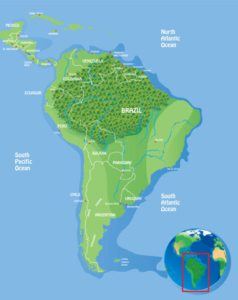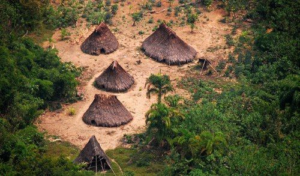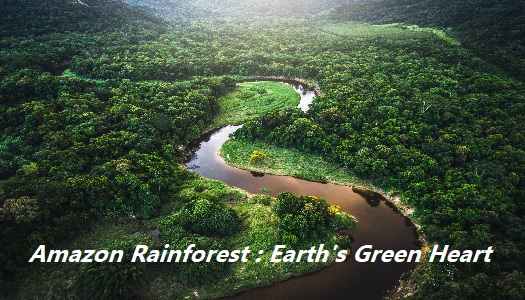Amazon Rainforest
The Amazon Rainforest, often called the “Lungs of the Earth,” is a magical and incredibly important place that stretches across South America.
The Amazon Rainforest is the largest rainforest on Earth, covering an area of approximately 6.7 million square kilometers (2.7 million square miles).
The Amazon Rainforest is so large that it occupies 40% of South America’s continent and can easily contain the UK and Ireland 17 times over.

Let’s embark on a journey to discover the wonders of this vast and lush green paradise, home to an astonishing variety of plants, animals, and people.

- A Green Symphony of Life:
- The Amazon Rainforest is like a massive, bustling orchestra of life. With around 390 billion trees and over 16,000 different species, it’s one of the most biodiverse spots on our planet.
- From colorful butterflies to playful monkeys swinging through the trees, every corner of the Amazon is teeming with life.
- It is also home to millions of species of plants, animals, and insects, many of which are not found anywhere else in the world.
- Where is it?
- Picture this: a sprawling jungle covering parts of nine countries—Brazil, Peru, Colombia, Venezuela, Ecuador, Bolivia, Guyana, Suriname, and French Guiana. That’s where the Amazon Rainforest calls home.
- The majority of Amazon rainforest lies in Brazil (around 60%), followed by Peru (around 13%), Colombia (10%), and a minority in Bolivia, Venezuela, Ecuador, Guyana, Suriname, and Guiana.
- The Mighty Amazon River
- Imagine a giant river flowing through this green wonderland. That’s the Amazon River, the second-longest river globally, with the Nile being the largest one. But according to its volume, the Amazon River is the largest river in the world. The Amazon River has more than 1100 tributaries. Creating a watery highway for countless creatures and shaping the landscape in its journey.
- The Weather Dance:
- The Amazon Rainforest has a dance with the weather. It experiences a tropical climate with high temperatures and lots of rain. There’s a wet season and a dry season, and this rhythm influences everything from the growth of plants to the activities of animals.
- Rainforest Defenders:
- The Amazon Rainforest faces challenges, especially from deforestation.
- Humans, in their quest for resources, cut down trees for things like farming and logging. This threatens the delicate balance of this vibrant ecosystem.
- However, there are brave defenders—conservationists, indigenous communities, and people worldwide—working hard to protect and preserve the rainforest.
- Indigenous Stories:
- Among the towering trees and winding rivers live indigenous communities with deep connections to the forest.
- They have unique cultures, relying on the rainforest for their homes, food, and traditions.
- Their stories are an integral part of the Amazon’s rich tapestry.
- When it rains, it takes approximately 10 minutes to reach the raindrops on the forest ground, owing to the thickness of the rainforest.
- The Amazon Rainforest is so thick that the floor remains in eternal darkness.
- It is said that only 1% of the sunlight is able to reach the ground of the rainforest.
- Nature’s Pharmacy:
- The Amazon is like a gigantic medicine cabinet. Indigenous people have known this for generations, using plants for healing.
- Many of the medicines we use today come from the rainforest, showing the importance of preserving this natural pharmacy.
- Climate Change Hero:
- The Amazon Rainforest is a superhero in the fight against climate change.
- It acts as a massive carbon sink, absorbing and storing tons of carbon dioxide and helping to keep our planet cool.

Amazon rainforest tribes
The Amazon Rainforest is home to numerous indigenous tribes, each with its own unique languages, cultures, and ways of life.
These tribes have lived in harmony with the rainforest for generations, relying on its resources for sustenance, medicine, and spiritual practices. Here are a few examples of indigenous tribes in the Amazon Rainforest:

- Yanomami:
- The Yanomami people reside in the border regions of Brazil and Venezuela. They are known for their traditional communal lifestyle, shamanistic practices, and complex social structure.
- Kayapó:
- The Kayapó, also known as the Mebêngôkre, inhabit the Brazilian Amazon. They are known for their vibrant ceremonies, body painting, and intricate beadwork. The Kayapó have been actively involved in environmental conservation efforts.
- Asháninka:
- The Asháninka people live in the rainforests of Peru and Brazil. They are one of the largest indigenous groups in the Amazon, known for their agricultural practices and traditional knowledge of plant medicine.
- Matsés:
- The Matsés, also known as the Mayoruna, reside in the border area between Peru and Brazil. They have a deep understanding of medicinal plants and have actively participated in initiatives to protect their territory.
- Xingu Peoples:
- The Xingu Indigenous Park in Brazil is home to several tribes, including the Xavante, Kayapó, and Waurá. These tribes are known for their diverse cultural practices, including body painting, music, and elaborate rituals.
- Tucano:
- The Tucano people live in the Amazon regions of Colombia and Brazil. They are skilled craftspeople, known for their pottery and basket weaving. Tucano communities often practice a form of shifting agriculture known as swidden farming.
- Awá:
- The Awá people are one of the last nomadic hunter-gatherer tribes in the Amazon. They inhabit the northeastern part of the Brazilian Amazon and have faced threats from illegal logging and encroachment on their territory.
- Yora:
- The Yora people live in the remote rainforests of southeastern Peru. They were first contacted by the outside world in the 1970s and have faced challenges due to diseases and encroachment on their land.
It’s important to note that these are just a few examples, and there are many more indigenous tribes in the Amazon Rainforest, each with its own unique cultural heritage.
The preservation of their rights, territories, and traditional practices is crucial for the overall conservation of the rainforest and its biodiversity.
In the heart of South America, the Amazon Rainforest is a treasure trove of life and beauty. It’s not just a distant place; it’s a vital part of our shared home.
As we learn more about this incredible ecosystem, let’s work together to protect and preserve the Amazon Rainforest for future generations, ensuring that its vibrant symphony of life continues to enchant the world.
Top 10 Popular Movie Review Websites
References:
worldwildlife.org/stories/what-animals-live-in-the-amazon-and-8-other-amazon-facts











